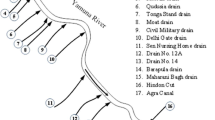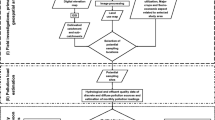Abstract
In water quality management, pollution control strategies have been sought to accord with the assimilative capacity of water bodies so as to preserve water quality. The waste load allocation (WLA) is a useful approach to determine the allowable loading of pollution sources in water quality management. For any WLA, a particular water body condition is needed as a basic scenario under which the relevant parameters are fixed. The particular flow rate is known as design flow and usually set at low flow in order to be protective. The design flow is traditionally a particular deterministic value, such as Q 75, implying that it is expected that the probability of water quality violation is 25% in the long run. However, this long-term expectation might not be realized in individual years due to variability of natural flow. The flow variability will make a WLA plan overoptimistic or over-conservative in different years, suggesting that the deterministic design flow without uncertainty consideration might lead to an ineffective or inefficient decision-making. To address the problem, we explicate the relationship between flow variability, design flow and water quality with different flow distributions to facilitate the understanding of the process of a WLA. In order to manifest the uncertainty effects of design flow, the results from the annual flow duration curve (AFDC) is compared with the conventional flow duration curve (FDC). The AFDC approach is capable of obtaining the uncertainty level of the design flow by generating the confidence interval rather than a fixed value. The effect of different record lengths on design flow determination is estimated as well. Finally, a refined WLA process is proposed with a re-examination of water quality violation to improve the allocation decision under uncertainty. TaHan River Basin in northern Taiwan is used as a case study.
Similar content being viewed by others
References
Aalderink, R. H., Zoeteman, A., & Jovin, R. (1996). Effect of input uncertainties upon scenario predictions for the River Vecht. Water Science and Technology, 33(2), 107–118.
Burn, D. H., & Lence, B. J. (1992). Comparison of optimization formulations for waste-load allocations. Journal of Environmental Engineering, 118(4), 597–612.
Carson, Y., & Maria, A. (1997). Simulation optimization: methods and applications. Proceedings of the 1997 Winter Simulation Conference, pp 118–126.
Castellarin, A., Galeati, G., Brandimarte, L., Montanari, A., & Brath, A. (2004a). Regional flow-duration curves: reliability for ungauged basins. Advances in Water Resources, 27, 953–965.
Castellarin, A., Vogel, R. M., & Barth, A. (2004b). A stochastic index flow model of flow duration curves. Water Resources Research, 40(3), W03104.
Chaleeraktrakoon, C. (1999). Stochastic procedure for generating seasonal flows. Journal of Hydraulic Engineering, 4(4), 337–343.
Chang, C. K. (2005). Pollution source survey and prevention program assess for the Ta-Han river Basin. 96 pp. Master Thesis, Graduate Institute of Environmental Engineering, National Taiwan University, Taiwan (in Chinese).
Chapra, S. C., & Pelletier, G. J. (2003). QUAL2K: A modeling framework for simulating river and stream water quality: documentation and user’s manual. 121 pp. Civil and Environmental Engineering Dept., Tufts University.
Cigizoglu, H. K., & Bayazit, M. (2000). A generalized seasonal model for flow duration curve. Hydrological Processes, 14, 1053–1067.
Gu, R., & Dong, M. (1998). Water quality modeling in the watershed-based approach for waste load allocations. Water Science and Technology, 38(10), 165–172.
Hakanson, L. (1996). A new, simple general technique to predict seasonal variability of river discharge and lake temperature for lake ecosystem models. Ecological Modelling, 88, 157–181.
Haung, T. I. (2005). QUAL2K Applied on the dervation of the optimal sanitary sewer collection rates in the Non-tidal influenced section of Damshui River. 109 pp. Master Thesis, Department of Safety, Health and Environmental Engineering, National United University, Taiwan (in Chinese).
Kao, J. J., & Bau, S. F. (1996). Risk analysis for flow duration curve based seasonal discharge management programs. Water Research, 30(6), 1369–1376.
LeBoutillier, D. W., & Waylen, P. R. (1993). A stochastic model of flow duration curves. Water Resources Research, 29(10), 3535–3541.
Lence, B. J., & Takyi, A. K. (1992). Data requirements for seasonal discharge programs: an application of a regionalized sensitivity analysis. Water Resources Research, 28(7), 1781–1789.
Mahajan, A. U., Chalapatiran, C. V., & Gadkari, S. K. (1999). Mathematical modeling - A tool for coastal water quality management. Water Science and Technology, 40(2), 151–157.
McCuen, R. H., & Beighley, R. E. (2003). Seasonal flow frequency analysis. Journal of Hydrology, 279, 43–56.
Melching, C. S., & Yoon, C. G. (1996). Key sources of uncertainty in QUAL2E model of Passaic River. Journal of Water Resources Planning and Management, 122(2), 105–113.
Mujumdar, P. P., & Vemula, V. R. S. (2004). Fuzzy waste load allocation model: Simulation-optimization approach. Journal of Computing in Civil Engineering, 18(2), 120–131.
Neelakantan, T. R., & Pundarikanthan, N. V. (2000). Neural network-based simulation-optimization model for reservoir operation. Journal of Water Resources Planning and Management, 126(2), 57–64.
NRC (National Research Council) (2001). Assessing the TMDL approach to water quality management, 109 pp., National Academy Press.
Osidele, O. O., Zeng, W., & Beck, M. B. (2003). Coping with uncertainty: a case study in sediment transport and nutrient load analysis. Journal of Water Resources Planning and Management, 129(4), 345–355.
Park, S. S., & Lee, Y. S. (2002). A water quality modeling study of the Nakdong River, Korea. Ecological Modelling, 153, 65–75.
Reckhow, K., Arhonditsis, G., Kenney, M., Hauser, L., Tribo, J., & Wu, C., et al. (2005). A predictive approach to nutrient criteria. Environmental Science and Technology, 39(9), 2913–2919.
Salas, J. D., & Obeysekera, J. T. B. (1992). Conceptual basis of seasonal streamflow time series models. Journal of Hydrologic Engineering, 118(8), 1186–1194.
Shabman, L., & Smith, E. (2003). Implications of applying statistically based procedures for water quality assessment. Journal of Water Resources Planning and Management, 129(4), 330–336.
Smakhtin, V. U. (2000). Estimating daily flow duration curves from monthly streamflow data. Water SA, 26(1), 13–18.
Smakhtin, V. U. (2001). Low flow hydrology: a review. Journal of Hydrology, 240, 147–186.
Smith, E. P., Ye, K., Hughes, C., & Shabman, L. (2001). Statistical assessment of violations of water quality standards under Section 303(d) of the Clean Water Act. Environmental Science & Technology, 35(3), 606–612.
Vogel, R. M., & Fennessey, N. M. (1994). Flow-duration curves. I: New interpretation and confidence intervals. Journal of Water Resources Planning and Management, 120(4), 485–504.
Vogel, R. M., & Fennessey, N. M. (1995). Flow duration curves. II: A review of applications in water resources planning. Water Resources Bulletin, 31(6), 1029–1039.
Warwick, J. J., & Roberts, L. A. (1992). Computing the risks associated with wasteload allocation modeling. Water Resources Bulletin, 28(5), 903–914.
Yu, P. S., Yang, T. C., & Wang, Y. C. (2002). Uncertainty analysis of regional flow duration curves. Journal of Water Resources Planning and Management, 128(6), 424–430.
Author information
Authors and Affiliations
Corresponding author
Rights and permissions
About this article
Cite this article
Chen, CF., Ma, HW. The uncertainty effects of design flow on water quality management. Environ Monit Assess 144, 81–91 (2008). https://doi.org/10.1007/s10661-007-9947-0
Received:
Accepted:
Published:
Issue Date:
DOI: https://doi.org/10.1007/s10661-007-9947-0




